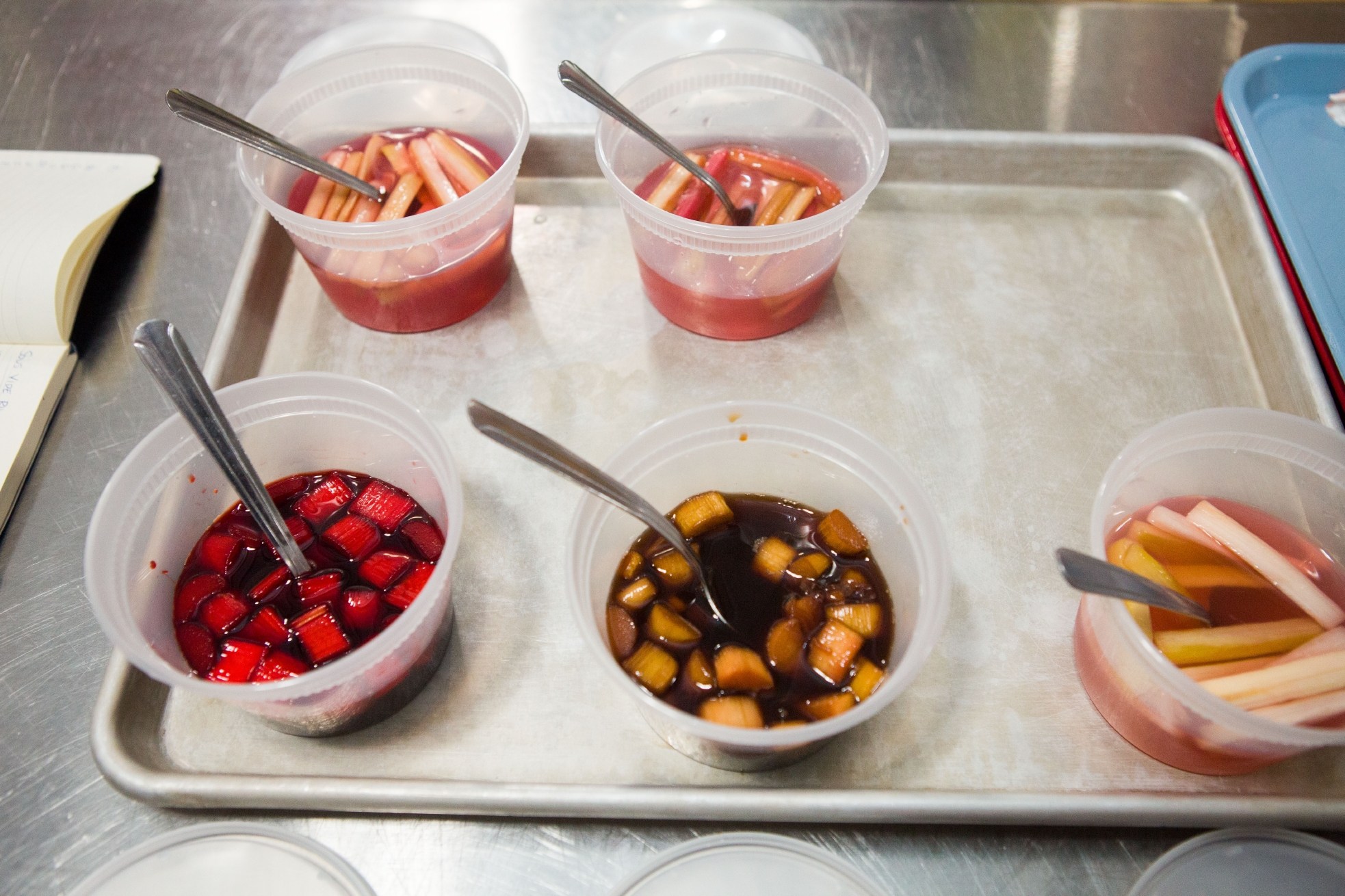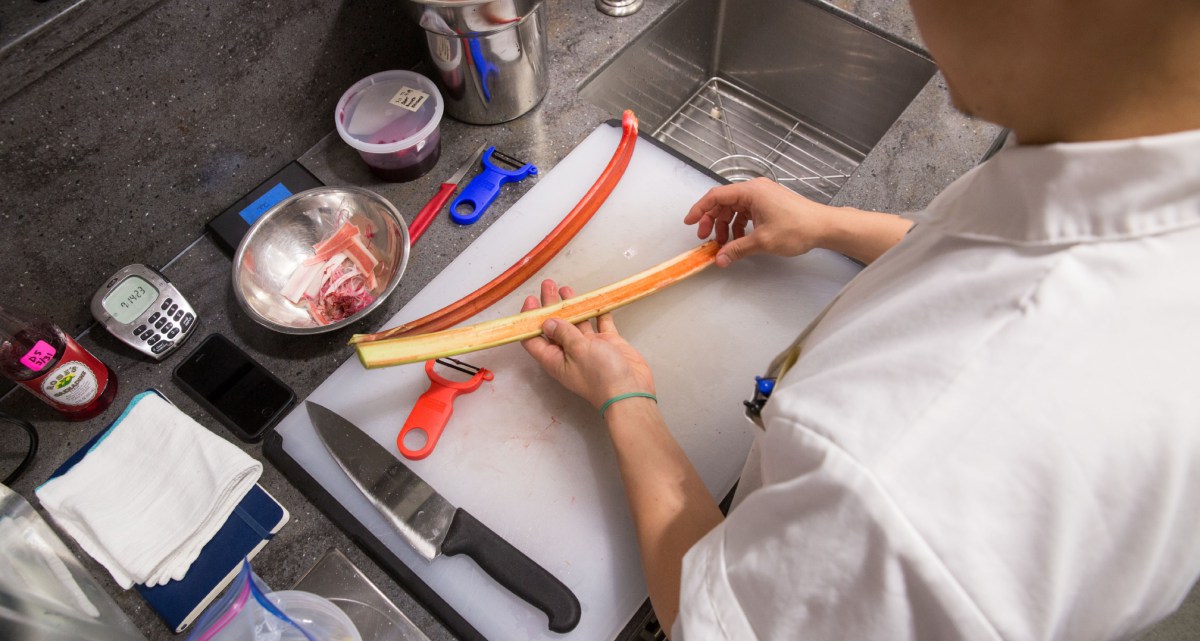In this weekly series, associate editor Tim Chin and test cook Sasha Marx take you behind the scenes of Cook’s Science and give you a glimpse into our recipe development process, from how we come up with recipe ideas, to test kitchen failures, to discoveries we make along the way. This week, Tim welcomes spring with rhubarb recipe development.
Spring is here. The air is getting warmer. The trees are budding. For most people, that means shorts, sundresses, patio drinking, and maybe dusting off the old one-speed for a weekend joyride. For those who cook, spring means green garlic, green almonds, green strawberries, asparagus, morels, fresh peas, ramps, and rhubarb. Chefs lose their minds over spring, and for good reason: It’s a time to break free from the winter purgatory of root vegetables and citrus and to jumpstart creativity and celebrate nature’s bounty. And you can bet Sasha and I are all about that spring hype.
Lately I’ve been working with rhubarb, exploring some uses beyond pie. I’m working toward two dishes—one sweet and one savory—to showcase rhubarb’s versatility. And while I’ll touch on the specifics of some of my testing, this week has been more of a lesson for me in the development process—in imagining a dish and then creating it.
Rhubarb goes on the ever-growing list of things in the plant kingdom that could put you in an early grave. Its leaves contain about 0.5 percent oxalic acid—the same stuff that’s in Bar Keeper’s Friend—and if you ate enough of them (say, 17 pounds of the leaves for the average adult male), the acid would have a toxic effect on your kidneys and potentially kill you. So it’s a good thing no one eats the leaves. Plus, they’re bitter, fibrous, and gross. So we’ll stick to the stalks, which have negligible concentrations of oxalic acid, and are delicious! In their raw state, they have a crisp, tart flavor—reminiscent of lemon—that mellows when cooked with sugar.
Rhubarb’s pucker and fibrous texture make it challenging to work with if you’re making anything other than compote, jam, or pie. Eaten raw, rhubarb can be stringy and, to some, overwhelmingly sour (akin to eating raw lemon wedges). When cooked, it goes from intact and fresh to mushy and jam-like in a matter of minutes. This sensitivity to heat makes rhubarb more suited to gentler cooking methods like poaching or lightly simmering if you want to keep the stalks intact. That means it’s a good candidate for sous vide cooking.
Initially, my idea was to serve bigger pieces of crimson, gently cooked, sweetened rhubarb stalks over some sort of yogurt-y element—a riff on berries and cream, if you will. I ran into two problems out of the gate. First, it was nearly impossible to keep the stalks an even, deep red through poaching. Anthocyanins, the same pigments found in red onions, raspberries, and red cabbage, give rhubarb stalks’ exteriors their distinctive crimson color. But because rhubarb has so much water, when cooked, the pigments leach into the water and the stalks turn a pale, anemic pink. I tried everything to solve this problem—adding beet juice, hibiscus flowers, even red food dye to my poaching bag—and while some methods produced redder results, they distracted from the delicate rhubarb flavor. I wasn’t about to sacrifice flavor just so I could have some pretty-looking rhubarb. In a restaurant kitchen, I would have used a vacuum chamber to compress the rhubarb with a small amount of beet juice or other red liquid to impart color. But without resorting to such fancy equipment, keeping rhubarb red proved more challenging than I anticipated.
The second problem was texture. I had envisioned 3-inch-long, uniform batons of poached rhubarb. But no matter how long or at what temperature (short of boiling) I cooked the rhubarb, it was still stringy and made for an unpleasant eating experience. Even peeling didn’t solve the problem entirely. Sixteen tests in, and I still didn’t have anything I was happy with. I was hitting a rut, frustrated, and I almost abandoned the idea entirely.

But then Sasha reminded me to just make the dish. It’s easy to get bogged down in the minutiae of a particular technique and miss the forest for the trees. After all, my goal is always to make something good, something tasty. Up till now, I hadn’t presented my team with a complete dish—just one element, failure after failure. So I stepped back and made a few adjustments. I sliced the rhubarb smaller, I abandoned the idea of crimson rhubarb, and made an intense, deep red syrup to glaze the rhubarb. I whipped some skyr and cream to make a base for my dish. Then I called another tasting. This time, my team finally came around to the concept. And while the dish wasn’t perfect, I had finally communicated my idea on the plate. Armed with a more cohesive concept, I have more confidence in the direction of the dish. And we’ll see how it evolves over the coming days.
In any craft, they say that God (or the Devil, depending who you ask) is in the details. And it’s true. You can’t succeed as a cook without paying careful attention to the little things. But it’s also important to see and paint the big picture, to communicate your greater vision. Working (and failing) with rhubarb was a solid reminder of that.
Do you have experience with cooking rhubarb? Any fun tips, techniques, or favorite ways to prepare it? Drop us a line in the comments below.
Photography by Steve Klise and Kevin White.




